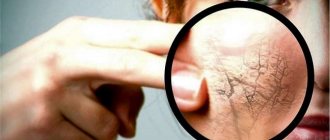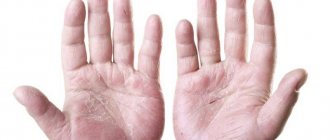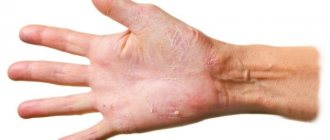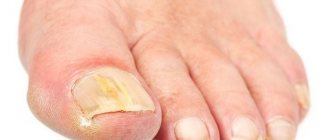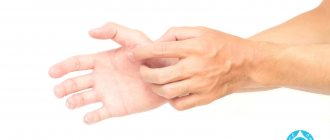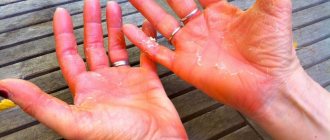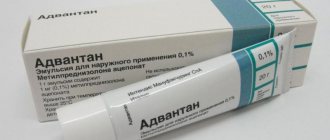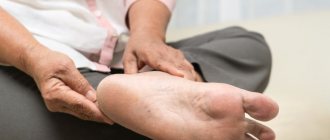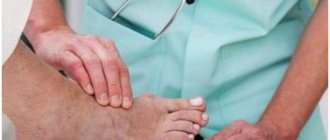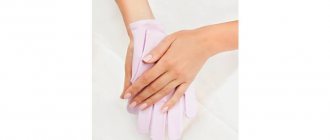Cracks on fingers near nails
If the skin on your fingers near the nails cracks, it is very unpleasant. On the one hand, cracked skin near the nails may seem like an insignificant detail, because such cracks are often invisible. But, on the other hand, if this problem is not solved, it can lead to such unpleasant consequences as:
Dry skin on hands
- Infection of the soft skin adjacent to the surface of the nail;
- The appearance of abscesses and abscesses, the formation of ulcers;
- The appearance of burrs;
- Rapid aging and roughening of the skin of the hands.
In order not to encounter these dangerous consequences, you should inspect the skin adjacent to the nail plate daily. If small cracks are visible there, and the skin becomes dry and begins to roughen, you should consult a dermatologist. A full examination and tests may be necessary to accurately diagnose the problem.
Cracked skin in these places negatively affects the condition of the cuticle. The cuticle dries out, and pain may be noticed when it is pulled back. Therefore, if you are prone to this problem, to prevent the cuticle from drying out, you need to regularly lubricate it with special oil. It is sold in pharmacies and cosmetic stores. Almond oil and care products containing a natural moisturizing factor are well suited for this purpose.
External reasons
It is much easier to cope with external causes of drying and cracking of the skin than with internal ones; to do this, it is enough to neutralize the negative influence of specific factors. But, if this factor begins to act on the skin again, the problem will immediately resume. External reasons may be the following:
- High or low temperatures;
- Scratches, abrasions or bruises;
- Burns;
- Using unsuitable care products.
On a note. It is more difficult to identify internal causes, since they are not caused by external factors, but by malfunctions in the functioning of the human body.
Sudden changes in temperature
Cracks near the nail plate can occur if you frequently wash dishes or take medicinal hand baths in very hot water. Firstly, the increased temperature of the liquid plays a role here. Secondly, tap hot water itself is considered “technical”, that is, it contains aggressive chemicals.
Attention! Also, the skin cracks as a result of prolonged exposure to ultraviolet rays, so before exposure to the sun it is necessary to apply a protective cream with special filters to your hands. Frost and strong winds also contribute to cracking of the delicate skin of the hands.
Mechanical and thermal injuries
On a note. The problem often occurs after burns, when blisters appear on the skin due to high temperature.
Then these blisters burst, and the skin, unable to withstand the tension, cracks. Also, cracks often appear after cutting the cuticle and improperly removing burrs. For prevention, the cuticle should never be cut; it should be carefully removed with a sharpened wooden stick. The burrs are carefully cut off with nail scissors, but not torn off.
Incorrect or insufficient skin care
Before purchasing skin care products, you need to correctly determine your own skin type. If it is dry, applying cosmetics for oily or normal skin will cause it to dry out and crack even more. Also, you should not change the brand of care product too often; it is advisable to use the same cream for at least a month so that the skin gets used to it.
Correctly determine your own skin type
Household chemicals
Fingers often become rough and cracked from frequent use of modern dishwashing detergents. Using nail polish remover containing acetone also has an extremely negative effect on the condition of your hands.
Attention! Frequent and prolonged contact with paints, solvents, and gasoline contributes to the appearance of cracks.
Internal reasons
Cracks in the skin of the fingers, their internal causes and treatment are a serious issue, because in this case the reasons for the roughening of the skin lie in the functioning of the body. Most often this happens when metabolism is disrupted or slowed down. Also reasons may be:
- Poor nutrition;
- Diabetes;
- Parasites;
- Endocrine pathologies.
In women, this often happens during pregnancy and menopause: the skin cracks, itches and flakes.
Avitaminosis
Lack of vitamins A, E and D is the most common internal cause of cracking of the skin on the hands in the nail area. To solve the problem, you need to adjust your diet and take vitamins or multivitamin complexes.
Diseases
On a note. Dry skin often indicates a serious disease such as insulin-dependent diabetes mellitus.
Therefore, if no external causes are identified, it is recommended to donate blood for sugar.
Helminthiasis
When the skin becomes rough and cracked in children and adolescents, this condition is often associated with a helminthic infestation. The presence of parasites in the body impairs the functioning of the immune system and weakens the barrier functions of the skin. To solve the problem, you need to get rid of the parasites.
Thyroid dysfunction
On a note. If the skin under your fingernails cracks and is very painful, this is often due to hormonal imbalances.
For example, this often happens with hypothyroidism, a serious disease of the thyroid gland. To prevent such conditions, it is necessary to regularly take iodine supplements.
Treatment of dry cuticles and skin around nails
Methods of combating dehydration should be comprehensive if the cause of dry epidermis is associated with internal factors.
When exposed to external conditions, emphasis should be placed on proper care with the selection of suitable products, taking into account the specific skin type. Treatment includes:
- nutrition correction;
- use of cream, masks, wraps and baths;
- use of ointments.
If your intake of vitamins from food is insufficient, you need to change your diet. The skin does not receive the substances it needs to maintain a healthy appearance, which is why it peels off in the future.
During the day, carrots, tomatoes, pumpkin or greens must be present in the diet. They are sources of vitamin A. Eggs, cheese, potatoes and corn are good sources of many nutrients. They are considered the most valuable due to the presence of vitamin E in their composition.
In addition to a diet enriched with vitamins, it is important to have sufficient water in the body (2-2.5 liters per day).
If you get tired of drinking tasteless liquid, then add ginger, lemon juice, honey or mint for variety.
Getting rid of the problem at home
In the evening, every day you need to moisturize the epidermis of your fingers in a bath with natural products. Dry cuticles are softened by adding vitamin E, lemon juice, milk or various oils. It is recommended to take baths in the evening for 15-20 minutes.
Remaining oils are removed with a napkin and the procedure is completed by applying a nourishing cream taking into account your skin type. Particular attention is paid to the areas around the nails.
To prepare the mask, use milk, boiled potatoes, rye bread, eggs, various oils and honey. The components are mixed in equal proportions until a thick consistency is obtained. If desired, no ingredient is added.
The mask is applied in a thick layer to the hands and fingers. Particular attention is paid to flaky areas. The duration of the procedure is no more than 20 minutes, and it is recommended to repeat it daily.
Use of pharmaceuticals
Additionally, for advanced forms, Radevit ointment is used. It is rich in nutritional components such as:
- vitamin A;
- glycerol;
- fatty acid;
- sunflower oil;
- Vaseline oil.
If the areas crack and treatment does not help, then Actovegin injections are used as a wound-healing drug. Sometimes you can pamper yourself with salon treatments (paraffin baths, hot oil manicure).
Professional cosmetics combine all the components necessary for the epidermis. After applying the product to problem areas, the skin becomes soft and velvety.
In most cases, the skin around the fingernails peels and dries due to vitamin deficiency and improper care. Nourishing cosmetics are best prepared at home. The main thing is to stock up on oils and combine them with ingredients that are beneficial for the skin.
Treatment methods at home
Cracked skin on fingers: causes and treatment
External remedies will help you cope with cracking at home. Before using them, you must make sure that you are not allergic to the components that make up a particular product.
Baths
Hand baths
To prepare a therapeutic bath, you need to take 2 tbsp. l. potato starch and dilute them in 1 liter of heated water. Hands are immersed in this bath for 20 minutes. The procedure must be carried out 2 times a week for a month.
Ointments
On a note. An effective ointment can be prepared at home.
To do this you need to take 100 grams. low-fat natural yogurt without flavoring additives and mix it with 1 tbsp. l. lemon juice. The resulting mass is applied to the skin near the nails and gently rubbed until completely absorbed. Use daily before bed for two weeks.
Creams
You can buy any product containing panthenol at the pharmacy. Experts say that the best remedy for dry skin is Bepanten cream. It can soften the skin well and is suitable not only for adults, but also for young children.
Anti-crack masks
Treating cracks with hand oil will help ensure active hydration and softening of the epidermis, as well as rapid healing of damage near the nail. There are many recipes for masks, among which everyone can choose something to their liking.
The simplest remedy is honey and olive or sea buckthorn oil. To prepare, you need to mix the necessary components in a ratio of 1:3. Apply the mixture to the problem area, put on cotton gloves on top to prevent it from smearing, and leave overnight.
An easy to prepare mask using grated raw potatoes and milk. Mix the components in any quantity. Apply the composition to your hands and put on gloves on top. After 2-3 hours, the mask should be washed off with warm water.
Regular use of masks for cracks on the hands near the nails will help the wounds heal quickly and prevent their occurrence in the future.
Prevention
Do not pick off burrs with your hands
To prevent cracking you need to:
- Eat properly;
- Use suitable cosmetics;
- Treat the cuticle correctly;
- Do not pick off burrs with your hands.
You should also take care of your nails daily and monitor the condition of the skin of your hands near the nail plates.
Before you treat cracked fingers, you need to know why it happens. Only after this can you use any folk remedies or pharmaceutical preparations. If the cause is not identified, the cracks may disappear for a while, but then they will certainly appear again.
Attention! Dealing with external causes is much easier than dealing with internal ones. To diagnose the causes, it is advisable to consult a specialist.
Elimination of provoking factors
If cracks appear around the nail on one or more fingers, you should think about why they appeared. This may be the result of prolonged exposure of hands to water, skin contact with a variety of detergents and disinfectants, as well as unfavorable environmental conditions.
To prevent this, all actions with water should be carried out only with special rubber gloves. They will reliably protect the skin of your hands from excessive moisture and prevent the aggressive effects of chemicals that are used for washing dishes, floors, walls and cleaning premises.
If cracks appear during the cold season, their occurrence may be due to unfavorable weather conditions. In this case, you need to go outside only wearing warm gloves, and do not expose your hands to the piercing wind and frost. Regularly use cosmetics to moisturize, nourish and protect the epidermis.
The problem can also be caused by improper skin care. The wrong choice of creams that are not suitable for your skin type can further dry out the epidermis, causing it to crack. In this case, you just need to change your cosmetics, and everything will get better very quickly.
Symptoms
When cracks appear, you need to pay attention to their location. If the problem affects the skin around the nails, this indicates frequent contact with detergents and moisture. The nail plates will begin to peel, peel, and crack.
When the pathology is not associated with constant contact with water, the prerequisites are fungus, hormonal changes, thyroid disease or diabetes. Cracking of the fingertips indicates a lack of vitamins and minerals.
Moreover, there is no irritation, redness or pain, the integument simply becomes rough. The addition of bleeding and pain indicates an internal disease and requires a mandatory consultation with a doctor.
Cracks near the fingers without the appearance of blood indicate the following reasons:
- long-term use of antibiotics;
- the effect of hormonal drugs;
- taking contraceptives.
Peeling also occurs under unfavorable weather conditions.
The greatest danger is a combination of cracks, dryness, and bleeding. In most cases, cracks are a sign of serious illnesses. If your fingers are swollen, you should consult an endocrinologist; the appearance of ulcers requires a visit to a surgeon.
Itching is often a symptom of an allergy or skin disease. A fungal infection is accompanied by burning, inflammation, swelling, and is a serious danger to others.
Symptoms of seizures
Depending on the type of pathogen that caused angulitis, the patient may experience characteristic symptoms.
If seizures are caused by the presence of streptococci, the patient feels
:
- discomfort and burning in the area of formation
- slight swelling of the affected area
- local hyperemia of the skin
- unpleasant pain when opening the mouth.
With candidiasis, bright red erosion becomes noticeable and becomes covered with a whitish coating. Often angulitis caused by the Candida fungus is chronic in nature with periodic exacerbations.
In advanced cases, the lips dry out and cracks that take a long time to heal may appear on them.
How jams form
When the pathogen penetrates the skin or mucous membranes, an inflammatory process begins to develop there. Its presence will be indicated by one or more small bubbles concentrated in the corners of the lips.
When you move your lips while eating, talking, and especially laughing, the bubbles, which contain transparent or slightly cloudy contents, burst, causing pain.
In place of the bubbles, small ulcers form, which eventually become covered with scabs.
